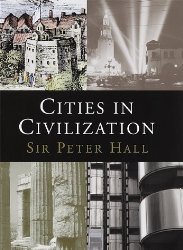The Planetizen 10 features the top 10 popular titles published in 2000 and 2001. Planetizen has partnered with Amazon.com to enable you to purchase any title by selecting the linked title of the book.
Suburban Nation: The Rise of Sprawl and the Decline of the American Dream 
by Andres Duany, Elizabeth Plater-Zyberk, and Jeff Speck (March, 2000)
Progressive town planning is the theme of this important new book, which closely examines the pattern of urban development in the United States over the past half century. The authors denounce the community destroying effects of urban sprawl, while prescribing the New Urbanist movement as a solution for creating vibrant cities, towns and neighborhoods.
Cities in Civilization 
by Peter Hall (February, 2001)
Comprised of case studies of individual cities throughout history, Cities in Civilization examines the role of the city in fostering humankind's artistic, philosophical, scientific, and technological prowess. Filled with details of the golden "urban" ages from Ancient Greece through Silicon Valley, the book is a tribute to the power of cities to mold and shape humanity.

Seduction of Place: The City in the Twenty-First Century
by Joseph Rykwert (September, 2000)
One of the most highly respected architectural historians of our time takes on the question of whether or not we have the cities we need and what we can do to create them.
The New Geography: How the Digital Revolution Is Reshaping the American Landscape
by Joel Kotkin (November, 2000)
Joel Kotkin rejects the idea that as role of technology in society becomes larger, the role of the city will diminish. Instead, he asserts that a shift in the way cities are used will occur, transforming our industrial and commercial centers into intellectual and cultural centers not unlike the great European cities of the Renaissance. Presented within the text are Kotkin's ideas for the new importance on "place", and his predictions for the death of cities as they are know today.
The Regional City: Planning For The End Of Sprawl 
by Peter Calthorpe and William Fulton (January, 2001) Two of the most innovative thinkers in the field of urban design offer a new vision for how metropolitan areas in the United States can grow wisely and overcome sprawl and inequity--by using physical design scenarios as well as regional social and economic policies.
Charter of the New Urbanism
Edited  by Michael Leccese, Kathleen McCormick, Robert Davis, and Shelley R. Poticha (February, 2000)
by Michael Leccese, Kathleen McCormick, Robert Davis, and Shelley R. Poticha (February, 2000)
An agenda for thriving urban centers -- the San Francisco-based Congress for the New Urbanism is a leading force for modern design that encourages viable neighborhoods, conserves natural environments, and preserves our architectural heritage. Charter of the New Urbanism introduces you to the work of the world-class planners, architects and other professionals who are making The New Urbanism happen.
How Cities Work: Suburbs, Sprawl, and the Roads Not Taken
 by Alex Marshall (January 2001)
by Alex Marshall (January 2001)
Do cities work anymore? How did they get to be such sprawling conglomerations of lookalike subdivisions, megafreeways, and big box superstores surrounded by acres of parking lots? And why, most of all, don't they feel like real communities? These are the questions that Alex Marshall tackles in this hard-hitting, easy-to-read look at what makes cities work.
Comeback Cities: A Blueprint for Urban Neighborhood Revival 
by Paul S. Grogan and Tony Proscio (September, 2000)
Comeback Cities details how and why America's inner cities have begun recovering from the pervasive crime and social disorder that plagued them only a decade ago.
Cities Back from the Edge: New Life for Downtown 
by Roberta Brandes Gratz and Norman Mintz (February 2000)
After decades of decline and decay, scores of downtowns in urban America are coming to life once again. Still, others continue to languish despite massive public investment. Based on their firsthand observations of downtown change throughout the country, the authors detail the stories of urban recovery from Mansfield, Ohio to Los Angeles, from Pasco, Washington to SoHo.
Married To The Mouse: Walt Disney World And Orlando 
by Richard E. Foglesong (July, 2001)
This intriguing book traces the evolution of the relationship between the Disney Co. and the surrounding community since it began in the 1960s--how Orlando leaders seduced the Disney Co. with big road projects, how the Disney Co. shielded its property from government regulation, and how the company has used the governmental powers it acquired. In short, Disney World has become a "Vatican with Mouse ears," the author declares.
Cities Back from the Edge: New Life for Downtown 
by Roberta Brandes Gratz and Norman Mintz (February 2000)
After decades of decline and decay, scores of downtowns in urban America are coming to life once again. Still, others continue to languish despite massive public investment. Based on their firsthand observations of downtown change throughout the country, the authors detail the stories of urban recovery from Mansfield, Ohio to Los Angeles, from Pasco, Washington to SoHo.
Placer County
City of Morganton
HUD's Office of Policy Development and Research
Dongguan Binhaiwan Bay Area Management Committee
City of Waukesha, WI
Los Angeles County Metropolitan Transportation Authority
Indiana Borough
Urban Design for Planners 1: Software Tools
This six-course series explores essential urban design concepts using open source software and equips planners with the tools they need to participate fully in the urban design process.
Planning for Universal Design
Learn the tools for implementing Universal Design in planning regulations.
